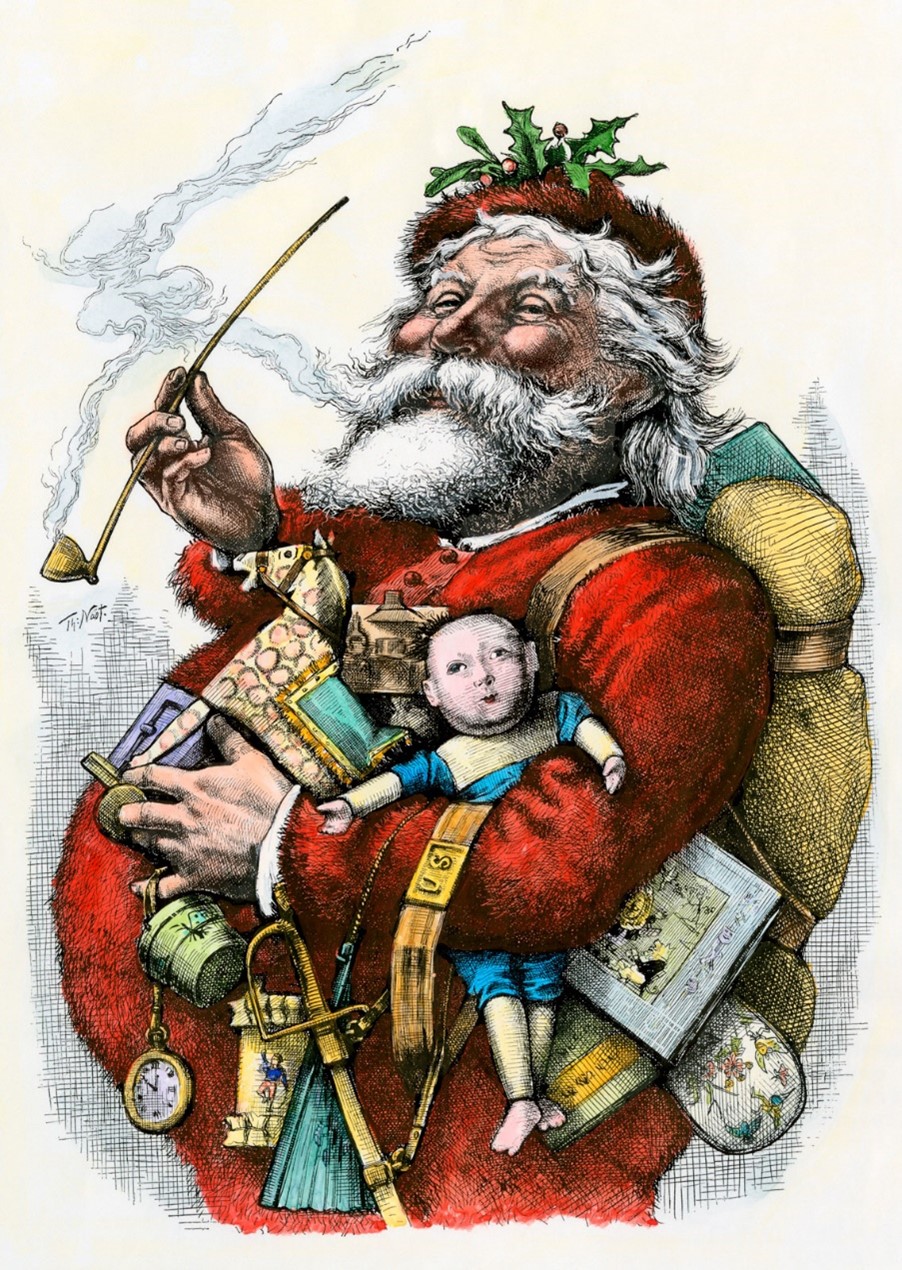SHOCK HORROR – FATHER CHRISTMAS IS AMERICAN!

Merry Old Santa, Thomas Nast, 1881
SHOCK HORROR – FATHER CHRISTMAS IS AMERICAN!
Actually, Father Christmas was Greek, born in 270 in today’s Turkey.
He died at the enormous age of 73 on December 6TH, 343. AKA Saint Nikolaos, Father Christmas was also enormously wealthy.
As an orphan, Nikolaos had been gifted the profits of a fabulously successful family business, the manufacture of “Imperial Purple”. This uniquely intense dye illumined the robes of every self-important nob in the classical world. It took the boiled poison glands of 12,000 Murex, the rock snail, to produce 1.4 grams of Imperial Purple – just sufficient to tinge the trimmings of one toga with its extortionately expensive magic hue.
The youthful Nikolaos was no well-born snowflake. Being a muscular Christian, tyro and intransigent, he took to his fists when he thought fit. He was also gifted with a keen intelligence expressed through a whiplash tongue.
The first Christian Emperor, Constantine of Byzantium, of the Eastern Roman Empire, expressly commanded his presence as Bishop of Myra at the fractious First Council of Nicaea. Ultimately, the now Nicholas of Myra, after a famously frenzied debate between 1800 bishops, became a broken nosed signatory of the critical Nicene Creed of 325: “We believe in one God, the Father Almighty, Maker of all things visible and invisible…”.
So much for his prominent public image. Unknown to all but a very few, Bishop Nicholas was discreetly and hugely generous, distributing his wealth, usually anonymously, to those he considered truly deserving – mainly needy children. One instance has been handed down to us: a poverty-stricken widower had three daughters who could not marry because they had no dowry, and were therefore destined for prostitution. On three successive nights, Nicholas tossed a bag of gold coin through the sleeping girls’ bedroom window. On the third night, the father caught Nicholas red-handed, much to his confusion. The father was sworn to secrecy, and his daughters made satisfactory marriages.
In an essentially brutalistic age, remarkable tales of miracles and selfless acts of charity were carried by traders across the Mediterranean, and further on into the far reaches of Northern Europe and Scandinavia, far beyond the range of any peripatetic monk. Firmly attached to these rumours of the coming of Christianity was the belligerent but benign reputation of Nicholas of Myra.
Following his death in old age, Nicholas was swiftly canonised by “general consent” – before such time as the Popes claimed the right for their own use.
The Feast of Saint Nicholas was celebrated on the day of his death, December 6th, on the eve of which gifts were secretly given to children who put a shoe out to receive them.
As it happened, the primeval pagan populations of the Northern hemisphere had long recognised a date in December as the Winter Solstice, the coming of light, of spring, when a day became its shortest, and a night its longest. Winter living could only have become easier, the chance of starvation would have been significantly lessened.
The timing of the celebration of the Winter Solstice was calibrated by astronomical observations from carefully oriented standing stones. Stonehenge would probably have spoken for us – still does.
In Northern Europe and Scandinavia, the Solstice celebrations were known as Yule, in the pagan Roman Empire, as the licentious festival of Saturnalia.
December 25th was the birthday of the Indo-Iranian god of light, Mithra. The widespread cult of Mithraism, primordial in origin, was the main rival to early Christianity – the two cults had many beliefs in common.
In 332, Emperor Constantine declared that December 25th was to be celebrated as Jesus Christ’s birthday. This was confirmed later by Pope Julius I: a smart diplomatic move to placate both factions.
In Northern Europe, the festivals of December 6th (St. Nicholas) and December 25th (Mithra and Jesus Christ) were eventually amalgamated in 1131 as cristes-messe.
It just so happened that the Scandi Yule was celebrated in December – what a coincidence. “Christmas” had arrived.
Party time!
The Vikings celebrated Yule with ribbon decorated ever-green trees in honour of their spirits; the sacrifice and eating of wild boar for the favour of the fertility god, Frey, and the burning of logs and the hanging of wreaths and mistletoe for the god of light and goodness, Balder. A favourite senior citizen would be dressed up as “Old Man Winter” in a hooded fur coat, travelling from homestead to homestead on a white horse to bring good cheer and join in the fun.
This was the original model of “Father Christmas”, echoing the long-bearded Odin on his horse, Sleipnir, and his business partner, the thundergod Thor, who was pulled around the heavens on a wagon drawn by goats.
In England, the archetypal curmudgeon, Oliver Cromwell, ruthlessly stamped out all this silliness, absolutely forbidding any form of celebration.
On the restoration of the frenchified King Chares II, Christmas fun and games were re-instated, but much subdued. Christmas was slow to recover its former pizzazz, but, by the time Queen Victoria had been on the throne for a year or two, it was back in full swing, bolstered by the newly wealthy “middle class” and her German consort, Prince Albert “The Good”, who had brought with him the ever-green Christmas tree along with its bright baubles and lights.
Charles Dickens helped.
Meantime, in 1615, the first Dutch settlers in America had taken with them their Sinterklaas, Saint Nicholas, who gained a firm foothold in New Amsterdam, on the southern tip of Manhattan Island. England v. Holland was a narrow defeat for England in 1664. England lost spice rich Surinam subsequently, but had bloodlessly swiped New Holland during a short lull in the fighting. New Amsterdam became New York, but Santa Claus remained deeply embedded in Manhattan.
We know that Saint Nicholas was slimly built, and tall for the time at 5’5 ¾ (shoe size 7 ½, hat size 6 ¼). We know because his remains were minutely examined on the renovation of his tomb in the crypt of the Basilica di San Nicola at Bari.
But why is Santa now so fat and florid?
Well, silly, it was the Americans, wasn’t it.
Yes, it was. Today’s version of Santa was first portrayed by the Bavarian immigrant caricaturist Thomas Nast in 1863 for the super-popular Harper’s Weekly. During the Civil War, his highly politicised Santa supported the Union. Nast developed his depiction over a period of 30 years, arriving eventually at the final image we all now know – having changed the colour of his silly hat and his robe to red, having given him an enormous paunch, definitively embonpoint, and a bad attack of the alcohol fuelled ruddy cheeks and bulbous nose of rosacea. To cap it all, he is always tediously jolly – and no doubt loud. No wonder small children are still terrified of him – or should be.
Ho Ho Ho.
In the 1920’s, Nast’s American Republican version of Santa, staunchly supporting the military, abolition of slavery and civil rights, was adopted by the advertising department of Coca Cola * – the ultimate insult.
We are now stuck with this redundant and diseased old brute who has little relevance to the spirit of Christmas.
Prior to today’s arrant commercialism, now that any old one can exchange gifts of any old value, it’s useful to remember that children were uniquely the ancient Santa’s beneficiaries. A truly wizard Christmas stocking would have contained –
- Oranges and apples for the three bags of gold
- A lump of coal for luck
- A bright new penny or two for wealth
- Some walnuts for wisdom
- Some sweets for pleasure
- A wooden soldier for a boy or a doll for a girl
Santa Claus / Saint Nicholas / Father Christmas is, at present, patron saint of children, sailors and ships and the wrongly condemned, to name his three most important posts, but he bears the record for patronages – some 150 occupations, from archers to wood turners, taking in lawyers, prostitutes, pharmacists and pawnbrokers – and not including causes, organisations, church bodies or, indeed, churches themselves.
Doctors do not figure.


